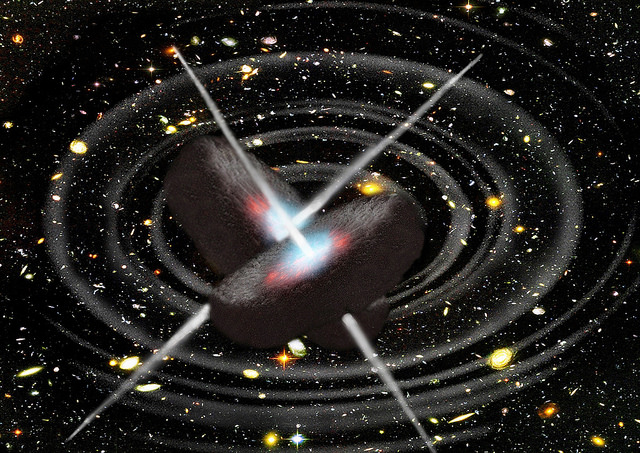Gravity Waves Detected 100 Years after Einstein’s Speculation.
Over a century ago Albert Einstein predicted that gravity propagated like waves in the Universe, similar to waves of light. However, at the time Einstein suspected that proving his 1916 Theory of Relative Gravity might be beyond the realms of technology.
Einstein believed that if gravity suddenly changed in a specific area due to a movement in space or a catastrophic space event, waves of gravitational energy would cause ripples to weave across the fabric of space at the speed of light. He anticipated that massive objects accelerating in the Universe, for example, black holes or exploding stars, could bend this fabric and cause gravitational waves that contain information about where they came from.
A simple way to understand gravitational waves is as though a heavy object is placed on a trampoline. The trampoline would bend to take the weight of the object. If another lighter object is also placed on the trampoline, it would roll towards the heavier object and the two would eventually collide. If another object is placed on it, even heavier than the first two, the lighter two would roll towards the heaviest one.
The bending and movement of the trampoline when objects are on it is a similar concept to what happens to a gravitational wave whenever one or more large objects moves through space. When a violent event occurs in space, such as two black holes colliding, the gravitational wave produced by the force would be even larger.
For 50 years Einstein’s theory was just speculation and for the past 25 years various methods have been tried and tested and instruments have been perfected in a determined effort to prove or disprove the suggested phenomena.
The reason gravitational waves are so difficult to detect is due to them being so far from Earth, so by the time the signal reaches us, the amount of space-time distortion that can be recorded is minimum.
However, today, February 11th 2016, scientists have confirmed that the 100 year-old theory is correct.
David Reitze, executive director of the Laser Interferometer Gravitational-Wave Observatory (LIGO) announced at a press conference today, “We have detected gravitational waves. We did it. It’s the first time the Universe has spoken to us through gravitational waves. Up until now, we’ve been deaf.”
LIGO used an Interferometer to look out for potential minuscule measurements. A single laser beam was split in two and the beams radiated outwards from two distant locations. If the beams travelled the same distance on their return, it means there were no distortions. If they are not aligned on return, then something has caused the disruption, most likely a gravitational wave.
LIGO explains, “At each observatory, the two-and-a-half-mile (4-km) long L-shaped LIGO interferometer uses laser light split into two beams that travel back and forth down the arms (four-foot diameter tubes kept under a near-perfect vacuum). The beams are used to monitor the distance between mirrors precisely positioned at the ends of the arms. According to Einstein’s theory, the distance between the mirrors will change by an infinitesimal amount when a gravitational wave passes by the detector. A change in the lengths of the arms smaller than one-ten-thousandth the diameter of a proton (10-19 meter) can be detected.”
On September 14th 2015, scientists detected a burst of gravitational energy that occurred 1.3 billion light years ago. It lasted just 20 thousandths of a second, which confirmed gravitational waves exist, as two black holes met, circled and collided.
The beginning of the signal explained how stars perish as the two black holes circled each other 30 times per second.
Towards the end of the recording they were circling one another 250 times per second before colliding, causing a dark merger.
LIGO explains on their website, “The gravitational waves that are detectible by LIGO will be caused by some of the most energetic events in the Universe—colliding black holes, exploding stars, and even the birth of the Universe itself. Detecting and analyzing the information carried by gravitational waves will allow us to observe the Universe in a way never before possible. This will open up a new window of study on the Universe, giving us a deeper understanding of these cataclysmic events, and usher in brand new cutting-edge studies in physics, astronomy, and astrophysics.”
The finding is the beginning of a new era for astronomy in the quest to fully understand gravity and the Universe in an entirely new way. The information that can be analysed from a gravitational wave can provide insights into the Big Bang theory and other catastrophic universal events.
The reason this unique finding is such a big event is that astronomical events such as black holes colliding do not give off light, so up until recently they weren’t detectable with telescopes, electromagnetic waves, radio waves, X-ray or visible light. However, these things experience interference as they travel across the universe, so we only receive a minimal amount of information.
Fortunately, with the use of an interferometer gravitational waves have been detected and the advantage is that they have no barriers and are not blocked by objects in the same way as light is. This means that gravitational waves are profound and pristine carriers of information and are able to provide us with a remarkable amount of data about the event that caused them.
Gravitational waves open a window, which allows us to gain an insight into the nature of the universe and activity that took place billions of years ago. Celestial objects, such as black holes and neutron stars, have so far seemed mysterious and the exact size and shape of them has been a debatable subject.
With this new discovery scientists are anticipating that we are about to enter a new phase of astronomy, whereby, many great revelations about the early days of the universe could be on our way.
~
Gravitational waves explained:
Author: Alex Myles
Editor: Travis May
Image: Flickr/Maxwell Hamilton







Read 1 comment and reply